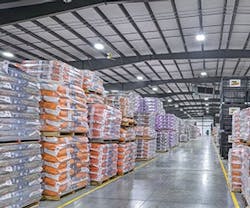Warehouse Visibility Boosted By Integrated LEDs
To fulfill its agricultural mission, Monsanto is reliant on quality illumination in its warehouses. In 2014, the corporation began searching for fixtures that could be used throughout its facilities to upgrade outdated HID lighting that was diminishing productivity and safety.
The company selected a production site in Grinnell, IA, to test lighting technologies. The facility had two industrial spaces that were equipped with aging 440W metal halides. The old lighting created several issues:
1) The lower energy efficiency had become a challenge to the facilities staff to meet sustainability goals.
2) Performance varied greatly depending on temperature. When operating in the cold weather, the lamps were unable to provide the full output needed to illuminate properly.
3) Bulk storage bins line the facility and can be stacked as high as 15 feet, which blocks lighting. This created lighting uniformity issues and dark spots throughout the aisles.
Minimizing safety risks for forklift operators was also a key reason for the upgrade.
“When staff would enter the warehouse from other sections of the facility, such as the packaging area, the lighting differences were so extreme that it would take a while for their eyes to adjust,” explains Mike Holliday, a professional engineer with Monsanto.
The company selected over 245 LED high bay fixtures to retrofit both production zones. The lamps save over 190 watts per fixture compared to the previous metal halides and payback is expected within five years.
The lamps are equipped with occupancy sensors, which detect movement from 15-20 feet away. Because the high bays have instant-on capabilities, staff are no longer reluctant to turn off the lighting like they were with the metal halides because of the slow startup time, Holliday notes. These features ensure the facility isn’t illuminated 24 hours a day.
Due to the increased light levels, the safety issues present before the upgrade have also been eliminated.
“The forklift operators agree it’s a night and day change,” says Philip Niemerg, an electrical engineer with Monsanto. “Before, their eyes took much more time to adjust upon entering and exiting the facility. By increasing their visual comfort, the number of safety hazards have been reduced.”
INFORMATION AND IMAGES COURTESY OF ACUITY BRANDS LIGHTING
For more real-world lighting projects:
Occupancy Sensors Conserve 1 Million kWh Annually
Niagara Falls Air Reserve Station | Niagara Falls, New York
Retail Parking Lights Save $10,000 Annually
280 Metro Center | Colma, California
Area LEDs Create Secure Parking for employees
Aflac Support Center | Columbus, Georgia
College Auditorium Reduces Lighting Demands by 80%
Haywood Community College | Clyde, North Carolina
